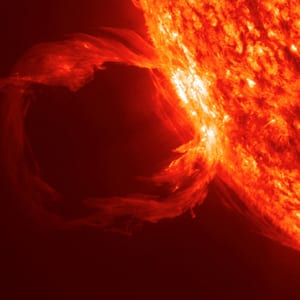The highs and lows of our nearest star, the Sun
By David R Shanks, on 9 December 2011
Solar researcher Dr Lucie Green from UCL’s Mullard Space Science Laboratory gave an excellent Lunch Hour Lecture on Tuesday 29 November. The talk responded to conflicting reports in the popular press about the activity levels of the Sun, and sought to inspire the audience with an appreciation of the beauty and significance of solar phenomena.
 It certainly wasn’t difficult to engage with this material on an aesthetic level. Coronal Mass Ejections, one of Dr Lucie Green’s specialities, were seen erupting magnificently from the surface of the Sun, and beautiful animated cutaways revealed the mechanisms taking place within.
It certainly wasn’t difficult to engage with this material on an aesthetic level. Coronal Mass Ejections, one of Dr Lucie Green’s specialities, were seen erupting magnificently from the surface of the Sun, and beautiful animated cutaways revealed the mechanisms taking place within.
It was emphasised that none of these were diagrams but visualisations of actual data. One became aware of the volume and variety of information being captured, and felt involved in its interpretation.
A history of observation began with Galileo in 1612 who had recorded dark areas on the surface of the Sun, possibly by projecting the image from a telescope onto paper and tracing the patterns produced. When viewed chronologically his drawings suggested a rotation of the Sun as distinct entities could be tracked across its surface.
Tallies of these sunspots have continued to provide a useful measure of the Sun’s activity, and a long graph of the last four hundred years’ counts made it obvious that we are presently on an upwards part of an activity curve, but that overall activity in the near future is likely to be lower. With the contradictory news stories explained, we were free to move into more interesting territory within the Sun and beyond its visible limits.
As the technology of telescopes advanced following Galileo, it was possible to observe ultraviolet and magnetic emissions in addition to visible light. Sunspots could be understood as results of activity in the gases beneath – the domain of helioseismology – and be classified in much greater detail. The Sun is now understood as a magnetic object with a field often stretching past Earth and protecting us from comic rays. Potential for an increase in the strength of this field has given rise to concerns for telecommunications, power and navigational systems, which is just one justification for understanding and close observation of these phenomena.
With these precepts explained far more beautifully than in my brief summary, it was possible to return to the topic of Coronal Mass Ejections, in which huge volumes of material are ejected from the Sun into the solar system at hundreds of metres per second. Dr Green outlined some of her current research into the elegant S-shaped field lines that twist between sunspots prior to such eruptions. Seeing examples of these, displayed like a case full of rare butterflies, gave that simultaneous pleasure to the eye and mind which is only possible when a presenter understands their subject so thoroughly.
Lunch Hour Lectures are a fantastic opportunity for immersion in an unfamiliar topic. Concise public talks by experts from throughout UCL are something of a dream come true, and you won’t even lose marks for tucking into your packed lunch.
Watch the full lecture here:
 Close
Close

